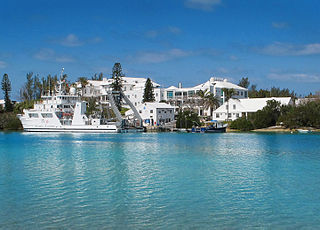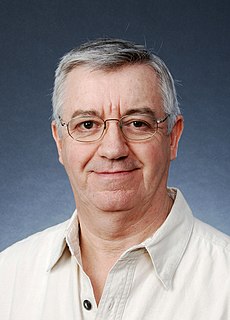Related Research Articles

The Kuroshio (黒潮), also known as the Black or Japan Current or the Black Stream, is a north-flowing, warm ocean current on the west side of the North Pacific Ocean. Like the Gulf Stream in the North Atlantic, the Kuroshio is a powerful western boundary current and forms the western limb of the North Pacific Subtropical Gyre.

Argo is an international program that uses profiling floats to observe temperature, salinity, currents, and, recently, bio-optical properties in the Earth's oceans; it has been operational since the early 2000s. The real-time data it provides is used in climate and oceanographic research. A special research interest is to quantify the ocean heat content (OHC).
SeaWIFS was a satellite-borne sensor designed to collect global ocean biological data. Active from September 1997 to December 2010, its primary mission was to quantify chlorophyll produced by marine phytoplankton.

The National Institute of Oceanography, founded on 1 January 1966 as one of 37 constituent laboratories of the CSIR, is an autonomous research organization in India to undertake scientific research and studies of special oceanographic features of the Northern Indian Ocean. Headquartered in Goa, it has regional centres in Kochi, Mumbai and Vizag.

USNS Indomitable (T-AGOS-7) was a United States Navy Stalwart class ocean surveillance ship in service from 1985 to 2002. From 2003 until 18 June 2014, she was in commission in the National Oceanic and Atmospheric Administration (NOAA) as the oceanographic research ship NOAAS McArthur II. As of 2018 it serves as a mother ship now named the Deep Submersible Support Vessel (DSSV) Pressure Drop for the manned deep-ocean research submersible DSV Limiting Factor.

The Bermuda Institute of Ocean Sciences is an independent, non-profit marine science and education institute located in Ferry Reach, St. George's, Bermuda. The Institute, founded in 1903 as the Bermuda Biological Station, hosts a full-time faculty of oceanographers, biologists, and environmental scientists, graduate and undergraduate students, K-12 groups, and Road Scholar groups. BIOS's strategic mid-Atlantic Ocean location has at its doorstep a diverse marine environment, with close proximity to deep ocean as well as coral reef and near shore habitats.
The Bermuda Atlantic Time-series Study (BATS) is a long-term oceanographic study by the Bermuda Institute of Ocean Sciences (BIOS). Based on regular research cruises, it samples an area of the western Atlantic Ocean nominally at the coordinates 31°40′N64°10′W. The cruise programme routinely samples physical properties such as ocean temperature and salinity, but focuses on variables of biological or biogeochemical interest including: nutrients, dissolved inorganic carbon, oxygen, HPLC of pigments, primary production and sediment trap flux. The BATS cruises began in 1988 but are supplemented by biweekly Hydrostation "S" cruises to a neighbouring location that began in 1954. The data collected by these cruises are available online.

The British Oceanographic Data Centre (BODC) is a national facility for looking after and distributing data about the marine environment. BODC is the designated marine science data centre for the UK and part of the National Oceanography Centre (NOC) — primarily at its facility in Liverpool, with small number of its staff in Southampton. The centre provides a resource for science, education and industry, as well as the general public.
The Continuous Plankton Recorder (CPR) Survey is one of the longest running marine biological monitoring programmes in the world. Started in 1931 by Sir Alister Hardy and Sir Cyril Lucas, the Survey provides marine scientists and policy-makers with measures of plankton communities, coupled with ocean physical, biological and chemical observations, on a pan-oceanic scale. The Survey is a globally recognised leader on the impacts of environmental change on the health of our oceans. Today the CPR Survey is operated by the Marine Biological Association(MBA), located in Plymouth, UK. Uniquely, the CPR Survey’s methods of sampling and plankton analysis remain unchanged since 1948, providing a spatio-temporally comprehensive > 70 year record of marine plankton dynamics.
Lynne Talley is a physical oceanographer at Scripps Institution of Oceanography known for her research into the large-scale circulation of water masses in the global ocean.

Gene Carl Feldman has been an oceanographer at NASA Goddard Space Flight Center (GSFC) since 1985. His primary interest has been to try to make the data that NASA gathers from its spaceborne fleet of Earth observing instruments, especially those monitoring the subtle changes in ocean color, as scientifically credible, readily understandable and as easily available to the broadest group of people possible. He has been involved in a number of past and present NASA missions including the Coastal Zone Color Scanner (CZCS), the Sea-Viewing Wide Field Sensor (SeaWiFS) and the Moderate-Resolution Imaging Spectroradiometer (MODIS) and along with the NASA Ocean Biology Processing group which he co-leads, been given the responsibility for designing, implementing and operating the data processing and mission operations component of ocean salinity mission called Aquarius, a space mission developed by NASA and the Space Agency of Argentina - Comisión Nacional de Actividades Espaciales (CONAE) that was successfully launched in June 2011 and began routine operations on December 1, 2011 and completed its prime mission in June 2015.
The Hawaii Ocean Time-series (HOT) program is a long-term oceanographic study based at the University of Hawaii at Manoa. In 2015, the American Society for Microbiology designated the HOT Program's field site Station ALOHA a "Milestone in Microbiology", for playing "a key role in defining the discipline of microbial oceanography and educating the public about the vital role of marine microbes in global ecosystems."
The Partnership for Observation of the Global Ocean (POGO), which was founded in 1999, is a consortium of major oceanographic institutions around the world, represented by their Directors. POGO's goal is to promote global operational oceanography, the implementation of a Global Ocean Observing System, and the importance of ocean observations for society. In 2020, POGO had 51 Members. The current Chairman (2019-2022) is Prof. Nick Owens.
The North Pacific Marine Science Organization, also called PICES, is an intergovernmental organization that promotes and coordinates marine scientific research in the North Pacific Ocean and provides a mechanism for information and data exchange among scientists in its member countries.

The British Mid-Ocean Ridge Initiative was a multidisciplinary scientific investigation of the creation of the Earth’s crust in the deep oceans. It was funded by the UK’s Natural Environment Research Council (NERC) from 1993 to 1999.
Gerold Siedler is a German physical oceanographer. He is professor emeritus at the Christian-Albrechts University of Kiel and at the GEOMAR Helmholtz Centre for Ocean Research Kiel.

NOAAS George B. Kelez, previously NOAAS George B. Kelez, was an American research vessel in commission in the National Oceanic and Atmospheric Administration (NOAA) fleet from 1972 to 1980. Prior to her NOAA career, she operated under the United States Fish and Wildlife Service′s Bureau of Commercial Fisheries from 1962 to 1970 as US FWS George B. Kelez and the National Marine Fisheries Service from 1970 to 1972 as NOAAS George B. Kelez.

The North Atlantic Aerosols and Marine Ecosystems Study (NAAMES) was a five-year scientific research program that investigated aspects of phytoplankton dynamics in ocean ecosystems, and how such dynamics influence atmospheric aerosols, clouds, and climate. The study focused on the sub-arctic region of the North Atlantic Ocean, which is the site of one of Earth's largest recurring phytoplankton blooms. The long history of research in this location, as well as relative ease of accessibility, made the North Atlantic an ideal location to test prevailing scientific hypotheses in an effort to better understand the role of phytoplankton aerosol emissions on Earth's energy budget.

Trevor Charles Platt was a British and Canadian biological oceanographer who was distinguished for his fundamental contributions to quantifying primary production by phytoplankton at various scales of space and time in the ocean.
Ann Gargett is a Canadian oceanographer known for her research on measuring turbulence and its impact on biological processes in marine ecosystems.
References
- 1 2 "About AMT". 2017. Retrieved November 16, 2017.
Since 1995 ... [this] has involved a total of 26 research cruises with 256 scientists from 22 countries
- ↑ "Publications". 2017. Retrieved November 16, 2017.
To date the AMT programme has produced over 300 refereed journal articles, including three special issues of journals
- ↑ "Cruises". 2017. Retrieved November 16, 2017.
... the annual return passage of research ships ... [is] a distance of up to 13,500km